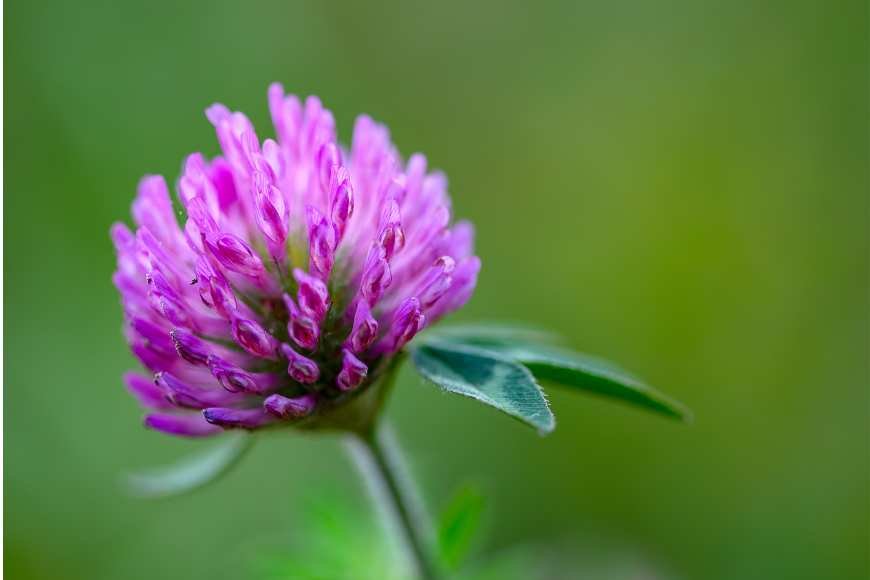Red clover and crimson clover almost sound the same. After all, crimson is one of the many shades of red. Nevertheless, they’re completely different plants that offer varied uses and benefits.
Red clover plants are typically used for their medicinal properties. The perennial clovers offer multiple benefits relating to bone, cardiovascular, skin, and hair health. In contrast, crimson clovers are better off in your garden, thanks to their soil-enhancing benefits.
Stick around to learn more about the difference between red and crimson clovers, as well as their benefits, uses, and side effects.
What Is the Difference Between Red Clover and Crimson Clover?

The difference between red and crimson clover mostly lies in their appearance. Upon first glance, you’ll notice the color difference. Red clovers are primarily pink and rosy, while crimson clovers are a strawberry-red shade.
In addition, crimson clovers tend to be much taller than their red counterparts. They boast an impressive 12 to 36 inches in height. Meanwhile, red clovers are usually slightly shorter and stand at a more humble 11 to 23 inches tall.
Other telltale differences between the two are their growth rate and seed size. Crimson clovers tend to grow faster and have larger seeds than red clovers.
Appearance aside, red clovers are classified under short-lived perennial legumes, whereas crimsons are a winter annual clover, germinating in late fall or winter and blooming in winter or spring.
Uses of Red Clover
Red clover holds plenty of prized uses. It offers a source of minerals such as calcium, niacin, chromium, magnesium, phosphorus, potassium, vitamin C, and thiamine.
It also holds isoflavones, a compound that imitates estrogen hormone function. In ointment form, the cultivar is applied on the skin to treat psoriasis and eczema, along with other skin irritant issues.
Using red clover also alleviates coughing, particularly in children. It also provides psychological benefits to women.
Apart from its medicinal uses, red clover also holds agricultural uses, including:
- Grazing
- Foraging
- Seed harvest
- Hay
Uses of Crimson Clover

One of the most notable uses of crimson clover is as a cover crop, whether for corn, wheat, or soybeans. As a cover crop, it’s grown to protect and enrich the soil.
When the cover crop plant is mixed or tilled into the soil, it’s referred to as green manure because of the beneficial nutrients it adds to the soil.
Crimson clover flowers growing is an indicator that it’s time for mowing and turning the soil.
Compared to red clover, crimson options are more popularly used for agricultural needs rather than for human health benefits.
Nonetheless, you can use crimson clover seeds as salad toppings once roasted. The shoots and sprouts of the annual are also used for summer dishes and salads.
Benefits of Red Clover
Interestingly, red clover is categorized under the same family as peas and beans. Now, while the legume has shown signs of treating menopause symptoms, osteoporosis, gout, and high cholesterol levels, further research is needed to verify its benefits.
That said, let’s dive deeper into each benefit below.
Osteoporosis Treatment
Research shows a link between a decrease in osteoporosis risk and consuming isoflavones, which are found in red clover.
How does this work?
Well, once a woman nears menopause, her estrogen levels decrease. As those hormones decrease, so does her bone mineral density.
Now, since isoflavones imitate the appearance of estrogen, a woman’s chances of developing osteoporosis decrease.
Skin and Hair Health Boost
A study of 109 women taking 80 mg of red clover for 90 days showed promising results when it comes to skin and hair health. They reported enhancements in their hair texture and skin appearance.
Another research comprising 30 men showed the perennial’s potential as a hair growth supplement. The experiment administered a 5% red clover extract on the men’s scalp for around four months. The group reported a 13% increase in hair growth rate.
While these studies show a step forward in red clover’s potential, more research is needed to cement this benefit.
Benefits of Crimson Clover
Crimson clover plants are best benefitted as a cover crop. They improve soil conditions by eliminating soil erosion, increasing nitrogen levels, and surface water pollution.
Similar to red clover, you can benefit from crimson clover by using it for foraging and grazing. Additionally, the plant lowers weed pressure, particularly during the fall and spring months.
One of the best parts of growing crimson clover is its impressive growth rate. It’s also a fast supplier of nitrogen, producing around 70 to 150 lbs.
Apart from that, crimson clovers are also environmentally beneficial since their red blooms provide nectar for nearby pollinators.
Side Effects of Red Clover

When taking red clover by mouth, you’ll need to be cautious since the isoflavones in the plant can cause certain side effects.
These include:
- Nausea
- Muscle aches
- Vaginal bleeding or spotting
Since the plant can act like estrogen, you don’t want to consume it if you have conditions that will worsen with increasing the hormone level. These conditions can include breast cancer, ovarian cancer, uterine fibroids, and uterine cancer.
Plus, if you’re pregnant or breastfeeding, avoid consuming red clover.
Side Effects of Crimson Clover
Since crimson clover isn’t usually used for consumption, there aren’t enough reports about the side effects of the plant.
To Conclude
What differentiates a red clover from a crimson clover? Well, both plants differ in appearance, height, classification, benefits, and uses. Crimson clovers are winter annuals and serve their purpose as a green manure crop.
Contrastingly, red clovers are perennials cultivated for their extensive health benefits, from preventing osteoporosis to enhancing cardiovascular health.
Overall, while both clovers share similar names, their properties and benefits couldn’t be farther from each other.
Also Read: Health Benefits of Caraway Tea

